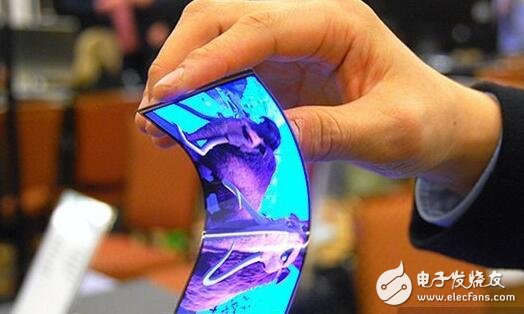OLED display technology is widely used in mobile phones, digital video cameras, DVD players, personal digital assistants (PDAs), notebook computers, car stereos and televisions. Organic light emitting diode (OLED) An organic light-emitting diode (OLED) is a patented display technology developed by Kodak that uses organic polymeric materials as a semiconductor material in light-emitting diodes. The polymeric material may be natural or synthetic, and may be very large in size or small in size. Proteins and DNA are examples of organic polymers. OLED display technology is widely used in mobile phones, digital video cameras, DVD players, personal digital assistants (PDAs), notebook computers, car stereos and televisions. OLED displays are thin and light because they don't use backlights. The OLED display also has a wide viewing angle of up to 160 degrees, and its operating voltage is two to ten volts (volt, expressed in V). The luminescent layer of the OLED is relatively light, so that its base layer can be made of a flexible material without using a rigid material. OLEDs do not require the use of backlighting systems in LCDs. When the LCD is working, it selectively blocks certain backlight areas, so that the image appears, and the OLED emits light by itself. Because OLEDs do not require a backlighting system, they consume less power than LCDs (most of the power consumed by LCDs are used in backlighting systems). A new OLED-based technology is Soft Organic Luminescence Display (FOLED), which has the potential to enable highly portable, folded display technologies in the future. Recently, "printed OLED" has been fired. The most common OLED printing technologies are inkjet printing (inkjetprinTIng) and screen printing (screenprinTIng). If the OLED printing technology is mature, it will be more conducive to the mass production and promotion of OLED. Quantum dot light emitting diode (QLED) QLED is an abbreviation for "Quantum Dots Light EmitTIng Diode Display", which is a quantum dot light emitting diode. The core imaging material of QLED is different from OLED (OLED is imaged by small molecule organic luminescent material), and its quantum dots are composed of zinc, cadmium, selenium and sulfur atoms. These quantum dots are very small in size and are only particles with a particle size of less than 10 nanometers, even smaller than some bacteria. Whenever a quantum dot is stimulated by light or electricity, it emits different colored light. This is the principle of QLED illumination. There are many advantages of QLED, including better contrast, wider color gamut, and manufacturers can control each pixel freely through software, giving you more control over the display. The QLED manufacturing process does not require the use of a shadow mask, so there is no problem of reduced accuracy. In addition, quantum dots can also be hovered in liquid and deposited using a variety of techniques, including inkjet printing on very thin, flexible or transparent substrates. Organic Light Emitting Crystal Display (OLET) The organic light-emitting crystal display (OLET) consists of three layers of material. The bottom layer is a substance that conducts electricity. The middle layer emits light when electricity passes through, and the upper layer controls the amount of light passing through. The entire set of materials is only 62 nm thick. At present, there are still some voltage problems to be overcome in the technology, but OLET can be 2 to 100 times more efficient than OLED, and can be used on any display screen in the future, and can even be used on a chip instead of a copper wire to transmit signals. Interferometer Regulator Display Technology (IMOD) Interferometer Regulator Display Technology (IMOD): A reflective display technology that is a new display technology that makes the display of a mobile phone clear and sharp even under sunlight. The process of displaying color is the same as the principle of glittering butterfly wings. Display devices based on iMD technology do not require a backlight. This display technology has significant low power performance compared to other display technologies, significantly extending the battery life of the device. Laser Phosphor Display (LPD) Laser Phosphor Display (LPD): Prysm's unique display technology and large display platform. It is the heart of all Prysm display solutions and represents the next generation of large-size digital displays. The LPD consists of the following main components: a laser engine, a laser processor, and a fluorescent panel. LPD uses a patented laser engine and phosphorescent phosphor panel to create stunning, body-sized images with low-power solid-state lasers. Fundamentally different from LED-based and liquid crystal-based display solutions, LPD solutions—including package configurations for LPD technology and other components—provide bright, equally-sized image quality, unparalleled viewing angles, and the industry's smallest environmental impact. Compared to other digital technologies, LPD technology has the lowest operating costs and offers the most advanced functionality, superiority and ease of use. Phase Control Thyristor is the abbreviation of thyristor, also known as silicon controlled rectifier, formerly referred to as thyristor; thyristor is PNPN four-layer semiconductor structure, it has three poles: anode, cathode and control pole; thyristor has silicon rectifier The characteristics of the parts can work under high voltage and high current conditions, and their working processes can be controlled and widely used in electronic circuits such as controlled rectifiers, AC voltage regulators, contactless electronic switches, inverters, and inverters. Phase Control Thyristor,Ir Phase Control Thyristor,Stud Phase Control Thyristor,Electronic Component Phase Control Thyristor,High Power Phase Control Thyristor YANGZHOU POSITIONING TECH CO., LTD. , https://www.cndingweitech.com